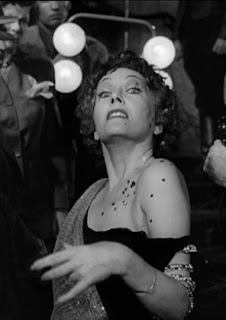I finally saw The Artist on Saturday, and for a full 24 hours I was in love with it. The valentine to the movieness of movies (shot in the Hollywood where I grew up). The technical artistry of recreating the era when, as my son once said, “the world was in black-and-white” (made even better by seeing it in a retro art house with a screen designed for the old square projection ratio). The utterly charming performances of everyone and everything from Jean Dujardin’s expressive eyebrows to Uggie the dog and his occasional stand-ins, Dude and Dash (robbed at the Oscars, the three of them). If I hadn’t been still recovering from the sausage-and-peppers incident, I’d have tapdanced out of the theater, buoyed by a delightful and distracting fairytale.
And then, yesterday afternoon, I started thinking. Fairytale, yes. But whose? And at whose cost?
[Word of caution: The following reflections refer to plot points and characters, so if you’re as delinquent in your moviegoing as I am and you still haven’t caught The Artist, consider yourself broadly spoiler-alerted.]
The Artist is a familiar enough tale, so much so that its director Michel Hazanavicius admitted to Charlie Rose that the story itself was negligible–it was how the film was made that made it special. A middle-aged silent screen star, George Valentin, proudly refuses to yield to what he thinks is the passing fad of talkies. His choice costs him his marketability, his marriage, his fame, his possessions, and nearly his life as he sinks into a suicidal depression. George is saved by the love of Peppy Miller, a much younger dancer to whom he’d once given a break, and who has become the biggest box-office draw in talking pictures. “I only wanted to help you, to take care of you . . .” Peppy tells George, whose pride is wounded when he discovers she has been acting as his guardian angel. The Artist ends as George and Peppy, now partners for life, execute a complicated tap routine in the musical Peppy has blackmailed her producers to offer George.
Aging man redeemed and rejuvenated by the adoring love of a younger woman. It seems to be the male equivalent of the Disney Princess trope, although in the girls’ version the Princes Charming are ordinarily much of an age with their sweeties. There’s one other critical difference, and that’s what got me thinking. In The Artist, as in many another older man-younger woman fairytale, there’s a character nobody talks about, except possibly to say Good riddance. There’s the aging woman, the old lady.
The real silence at the heart of The Artist is Doris Valentin, George’s wife. Played by Penelope Ann Miller (whose name is so similar to that of the character who replaces Doris in George’s life–Peppy Miller–that it seems there must be an intentional connection), Doris is depicted as a boring, vapid partner in a marriage long gone stale. She’s stopped gazing adoringly at George long ago, and she can’t hear him because he refuses to talk in real life as well as on screen. Doris gives George an ultimatum as his fortunes slide downhill–talk (about his plans to salvage his career, about his squandering their money on his doomed self-production, about their marriage), or get out. Silent as ever, George leaves, and Doris disappears from the movie and his life.
I could cheer George and Peppy more, in retrospect, if I didn’t find myself so sympathetic to Doris. It’s not that the facts of my own life are similar; they’re not. It’s not that I’m an aging woman, envious of the pretty young things; I’m aging, but not envious. I just wonder why Doris was necessary. In Billy Wilder’s terrific take on the male fairytale, Sabrina, for example, Humphrey Bogart’s a stuffy old bachelor redeemed by the gamin Audrey Hepburn. (We won’t discuss the remake.) There wasn’t a Mrs Linus Larrabee to be kicked to the curb in the process.
Too often, though, there’s a Doris who has to be silenced, erased, dispatched before the end title. And it makes me just a little queasy. It’s the same instinct that’s always made me pull for Eleanor Parker’s Baroness Schraeder in The Sound of Music–one of the most hated characters in cinema, apparently, for no other reason than that she’s not a singing novice in a dirndl who can’t take her eyes off the Captain.
As dispensable older women go, Doris and the Baroness get off fairly easily. Mrs Rochester had to be made syphilitic and mad and locked in an attic. Rebecca was a barren, cheating bitch with cancer. For an aging Prince Charming to be rescued by his Snow White, it seems, somebody’s gotta be the Witch.
It might be less problematic if there were equivalent older woman-younger man tales to balance the deficit, but don’t look to Hollywood. If The Artist is anything it’s a kind of anti-Sunset Boulevard, film blanc to that much bigger and better (and Billy Wilder again) classic film noir. The plot similarities have already been noted by many critics, but the gender reversal makes all the difference in the world. Norma Desmond is her own dispensable woman, her own witch. No younger man is going to bother saving her. Indeed, as we know from the film’s first frames, she’ll be the death of him.
I’m not arguing for a revisionist remake of Whatever Happened to Baby Jane in which Jane and Blanche get a career lift and a new lease on life from a chance encounter with a couple of the Jonas Brothers. What with the whole Demi Moore/Ashton Kutcher thing, nobody would buy it anyway. And my musings don’t alter one bit my enjoyment of the technical tour de force that is The Artist. I’m just . . . wondering. And one of the things I wonder about most is why I haven’t heard anybody else wonder. The silence of Doris Valentin–the silence about her–is deafening.
I wish George and Peppy well, I do, as they tap into the future together. Just forgive me if, as I raise my toast, I do so from this table in the corner I’m sharing with Baroness Schraeder et al. And Doris Valentin? Pull up a chair, honey. Believe me, we’ll talk.

.jpg)














